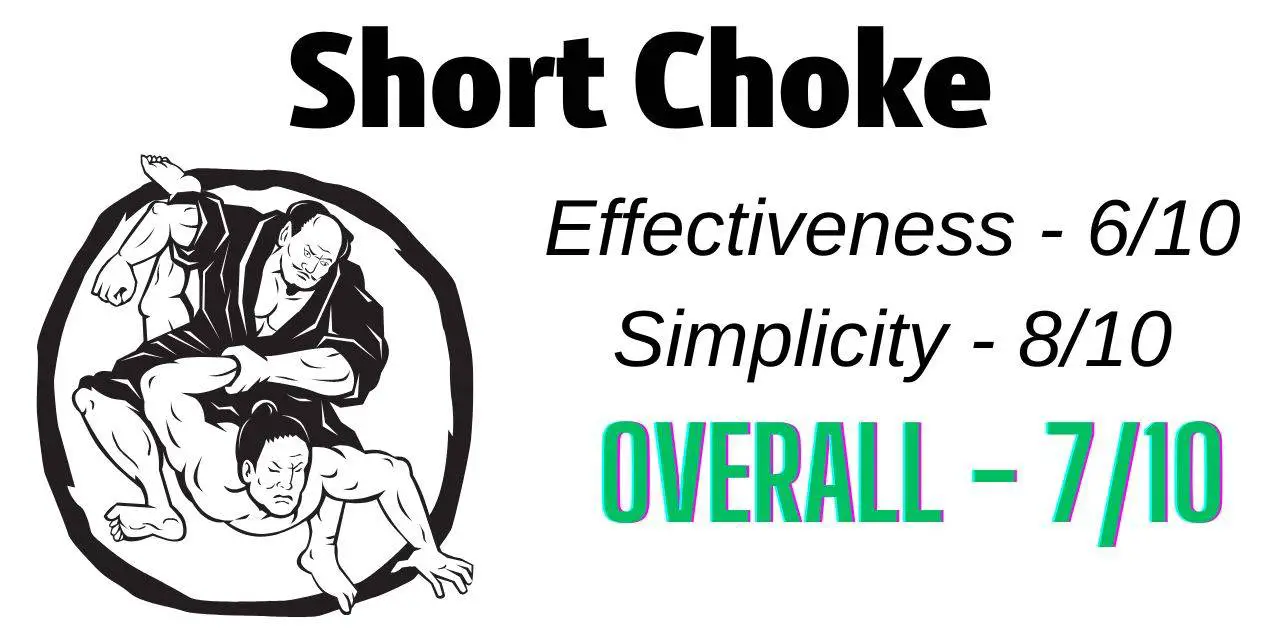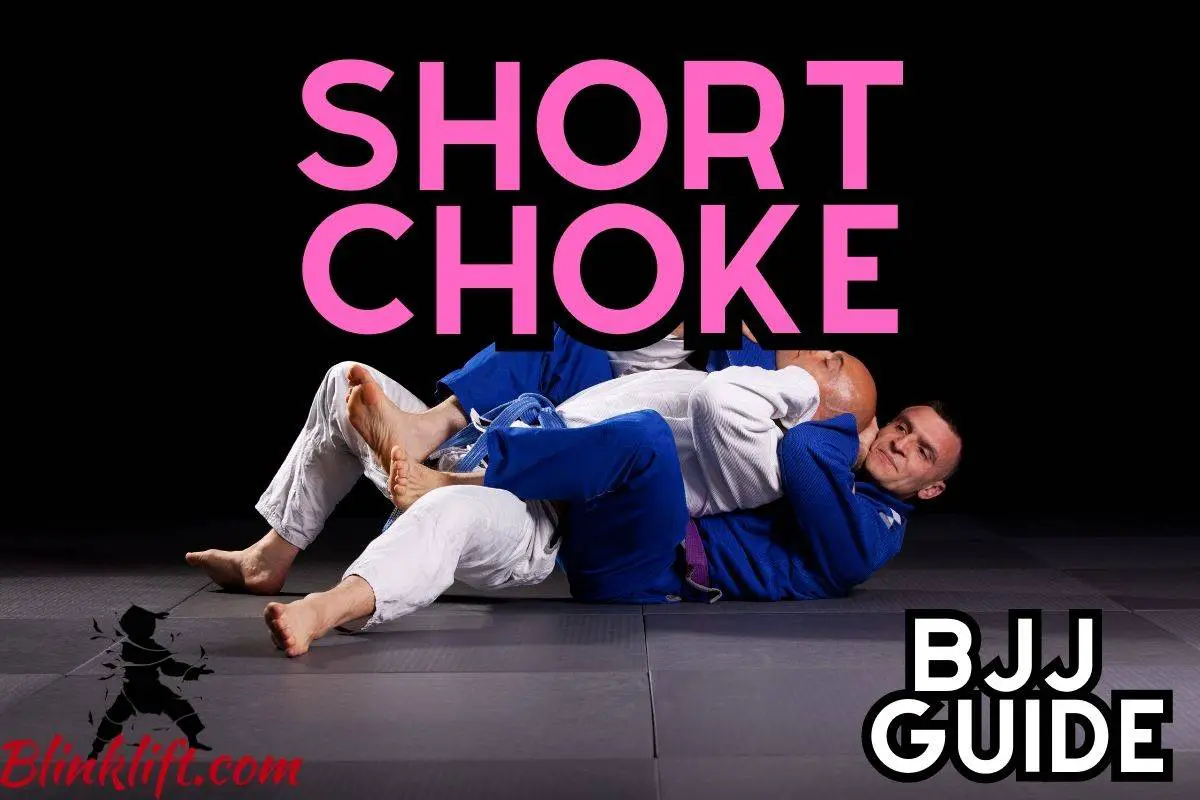Chokes in BJJ are critical to know and understand. They’ll help you get much more taps and skyrocket your grappling game. This article will help you learn and experiment with a potent submission, the Short Choke.
The Short Choke is a move you want to learn and understand since it’ll help you get plenty of taps, and do so quickly. It’s an uncomplicated submission you can learn in a single BJJ session, which means that you want to learn it when you’re a white belt.
Regardless of your belt color, you’ll be able to get your first wins using it quickly. And again, this is my primary intention with this article. If you read it in order—you’ll be able to get your first taps using it—quicker than you think.
So what will this article cover exactly? It’ll start by defining what it is. Then, it’ll review the necessary steps you need to take to perform it properly. And finally, we’ll go through a few details you want to know prior to starting your training.
Enough Chit Chat. I hope you’re ready to dive into the practical stuff. Because it’s up next!

What is the Short Choke in BJJ?
The Short Choke is, first of all, an alternative to the infamous Rear Naked Choke. Once you’ve tried the RNC and failed, you’ll typically try the Short Choke. What it does best is compensate for the fact that you’ve failed to apply one submission by allowing you to go for another without any consequences.
So what is the Short Choke in Brazilian Jiu Jitsu?
The Short Choke is a submission taught primarily in BJJ, although its use is widely practiced, especially in MMA. Its execution starts with the Back Mount and utilizes a Gable Grip to apply neck pressure. It’s an excruciating choke when done properly.
The primary use it has is a more refined version of the Rear Naked Choke. Although it’s not more effective: in fact, the opposite is true, it can nonetheless be used after the RNC has failed.
Let’s now review the steps to performing the Short Choke flawlessly, skyrocketing your success rate using it.
How to Perform the Short Choke
To perform the Short Choke properly, you want to start from the Back Mount position. If unfamiliar with it, follow this link to read more about it. This move has one restriction you want to know about; what it is—is essentially an after-move for the Rear Naked Choke.
What does that mean? In short, you want to go for the Rear Naked Choke at first. Then, once the opponent blocks your hand (typically the obstacle you’ll encounter), you go for the Short Choke.
Before we cover the step-by-step breakdown of this move, you want to know how to perform the Rear Naked Choke perfectly. Follow the link to learn everything you need to know about it.
So let’s see how to perform the Short Choke from the Back Mount properly:
- Start in Back Mount
- Go for the Rear Naked Choke
- The opponent disrupts you
- Lock your hands (cable grip)
- Place your left forearm behind his back
- Pull your right elbow back
- Apply pressure
- Wait for the tap
Really, this move isn’t difficult to learn. All you need to understand is the mechanism this Choke utilizes. At its core, it’s not just a replacement for the RNC, but it’s also a refined version of it. So it’ll be more suitable to use in many cases, making it far more attractive.
Difference Between Rear Naked Choke and Short Choke
The last thing we’ll discuss is the difference between the infamous Rear Naked Choke – and its less popular, yet better-refined colleague, the Short Choke. Before we dive into the difference, I do want to reveal my intention with this section for you.
Learning both of these chokes will be vital for your grappling skills, especially in the long term. These two feed each other perfectly and will allow you to skyrocket your BJJ game from the Back Mount.
While the Rear Naked Choke utilizes an X-shape between your arms and around the opponent’s neck to finish a fight, the Short Choke uses a Cable Grip while placing your far forearm behind the opponent’s back. So the primary difference is in the grips you use.
It’s far more likely you’ll be able to finish with the RNC if you’re decided which one to choose. So, it’s definitely worthwhile to learn the RNC before you study the Short Choke.
And still, once you got that done, you can advance to the move that this article is about and use it when the RNC seems to fail.
That’s the secret to using this choke. And you now know the secret that will allow you to get far more taps from the Back Mount using these two prominent chokes in BJJ.
Final Words
Hopefully, you found this article helpful. I’ve had a great time writing this instructional post because it allowed me to learn more about this magnificent Choke. And eventually, it’s something I feel privileged to do.
My intention with this article was to allow you to learn this move until eventual perfection. However, it’ll take time for you to learn and get comfortable with. So keep on learning and training without feeling burnt out, as results will come, and you have to know that.
BJJ is all about learning and attaining as much knowledge as possible. And this is what this website is about.
But, the Short Choke isn’t close to being a top-rated choke. If you want to learn about the best chokes in BJJ, follow this link to read about them and how to perform each one perfectly!
Here are other articles you’d enjoy reading:
BJJ 101: D’arce Choke (Lots of Variations)
BJJ 101: Omoplata (From Setup to Submission)
11 Best Half Guard Submissions From Top and Bottom
BJJ 101: Japanese Necktie (The Right Way)
Bow and Arrow Choke – From BJJ Beginner to Pro
BJJ 101: Ninja Choke – Complete Breakdown
BJJ 101: Helio Gracie Choke (From Closed Guard)
Ezekiel Choke 101 – Complete BJJ Guide

